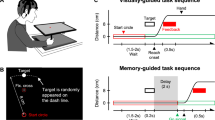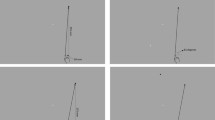Abstract
It has been well established that an implicit motor response can be elicited by a target perturbation or a visual background motion during a reaching movement. Computational studies have suggested that the mechanism of this response is based on the error signal between the efference copy and the actual sensory feedback. If the implicit motor response is based on the efference copy, the motor command accuracy would affect the amount of the modulation of the motor response. Therefore, the purpose of the current study was to investigate the relationship between the implicit motor response and the motor planning accuracy. We used a memory-guided reaching task and a manual following response (MFR) which is induced by visual grating motion. Participants performed reaching movements toward a memorized-target location with a beep cue which was presented 0 or 3 s after the target disappeared (0-s delay and 3-s delay conditions). Leftward or rightward visual grating motion was applied 400 ms after the cue. In addition, an event-related potential (ERP) was recorded during the reaching task, which reflects the motor command accuracy. Our results showed that the N170 ERP amplitude in the parietal electrodes and the MFR amplitude were significantly larger for the 3-s delay condition than the 0-s delay condition. These results suggest that the motor planning accuracy affects the amount of the implicit visuomotor response. Furthermore, there was a significant within-subjects correlation between the MFR and the N170 amplitude, which could corroborate the relationship between the implicit motor response and the motor planning accuracy.





Similar content being viewed by others
References
Abekawa N, Gomi H (2010) Spatial coincidence of intentional actions modulates an implicit visuomotor control. J Neurophysiol 103:2717–2727. https://doi.org/10.1152/jn.91133.2008
Adams JA (1971) A closed-loop theory of motor learning. J Mot Behav 3:111–150. https://doi.org/10.1080/00222895.1971.10734898
Binsted G, Rollheiser TM, Chua R (2006) Decay in visuomotor representations during manual aiming. J Mot Behav 38:82–87. https://doi.org/10.3200/JMBR.38.2.82-87
Bland JM, Altman DG (1995) Calculating correlation coefficients with repeated observations: part 2—correlation between subjects. BMJ 310:633. https://doi.org/10.1136/bmj.310.6980.633
Brenner E, Smeets JBJ (1997) Fast responses of the human hand to changes in target position. J Mot Behav 29:297–310. https://doi.org/10.1080/00222899709600017
Bridgeman B (1995) A review of the role of efference copy in sensory and oculomotor control systems. Ann Biomed Eng 23:409–422
Cruikshank LC, Caplan JB, Singhal A (2012) Human electrophysiological reflections of the recruitment of perceptual processing during actions that engage memory. J vis 12:1–13. https://doi.org/10.1167/12.6.29
Cruikshank LC, Caplan JB, Singhal A (2014) A perception-based ERP reveals that the magnitude of delay matters for memory-guided reaching. Exp Brain Res 232:2087–2094. https://doi.org/10.1007/s00221-014-3897-x
Davies L, Gather U (1993) The identification of multiple outliers. J Am Stat Assoc 88:782–792. https://doi.org/10.1080/01621459.1993.10476339
Day BL, Brown P (2001) Evidence for subcortical involvement in the visual control of human reaching. Brain 124:1832–1840. https://doi.org/10.1093/brain/124.9.1832
Day BL, Lyon IN (2000) Voluntary modification of automatic arm movements evoked by motion of a visual target. Exp Brain Res 130:159–168. https://doi.org/10.1007/s002219900218
Desmurget M, Grafton S (2000) Forward modeling allows feedback control for fast reaching movements. Trends Cogn Sci 4:423–431
Desmurget M, Epstein CM, Turner RS et al (1999) Role of the posterior parietal cortex in updating reaching movements to a visual target. Nat Neurosci 2:563–567. https://doi.org/10.1038/9219
Glover S (2004) Separate visual representations in the planning and control of action. Behav Brain Sci 27:3–24
Gomi H (2008) Implicit online corrections of reaching movements. Curr Opin Neurobiol 18:558–564. https://doi.org/10.1016/j.conb.2008.11.002
Gomi H, Abekawa N, Nishida S (2006) Spatiotemporal tuning of rapid interactions between visual-motion analysis and reaching movement. J Neurosci 26:5301–5308. https://doi.org/10.1523/JNEUROSCI.0340-06.2006
Gomi H, Abekawa N, Shimojo S (2013) The hand sees visual periphery better than the eye: Motor-dependent visual motion analyses. J Neurosci 33:16502–16509. https://doi.org/10.1523/JNEUROSCI.4741-12.2013
Goodale M (1998) Vision for perception and vision for action in the primate brain. Novartis Found Symp 218:21–34; discussion 34–9. https://doi.org/10.1002/9780470515563.ch3
Goodale MA, Milner AD (1992) Separate visual pathways for perception and action. Trends Neurosci 15:20–25
Goodale MA, Pelisson D, Prablanc C (1986) Large adjustments in visually guided reaching do not depend on vision of the hand or perception of target displacement. Nature 320:748–750. https://doi.org/10.1038/320748a0
Gritsenko V, Yakovenko S, Kalaska JF (2009) Integration of predictive feedforward and sensory feedback signals for online control of visually guided movement. J Neurophysiol 102:914–930. https://doi.org/10.1152/jn.91324.2008
Heath M, Westwood DA, Binsted G (2004) The control of memory-guided reaching movements in peripersonal space. Mot Control 8:76–106. https://doi.org/10.1123/mcj.8.1.76
Heath M, Neely KA, Yakimishyn J, Binsted G (2008) Visuomotor memory is independent of conscious awareness of target features. Exp Brain Res 188:517–527. https://doi.org/10.1007/s00221-008-1385-x
Kadota K, Gomi H (2010) Implicit visuomotor processing for quick online reactions is robust against aging. J Neurosci 30:205–209. https://doi.org/10.1523/JNEUROSCI.2599-09.2010
Kimura D, Kadota K, Kinoshita H (2015) The impact of aging on the spatial accuracy of quick corrective arm movements in response to sudden target displacement during reaching. Front Aging Neurosci 7:182. https://doi.org/10.3389/fnagi.2015.00182
Krigolson O, Bell J, Kent CM et al (2012) Reduced cortical motor potentials underlie reductions in memory-guided reaching performance. Mot Control 16:353–370. https://doi.org/10.1123/mcj.16.3.353
Kudo K, Ohtsuki T (2008) Adaptive variability in skilled human movements. Trans Jpn Soc Artif Intell 23:151–162. https://doi.org/10.1527/tjsai.23.151
Naranjo JR, Brovelli A, Longo R et al (2007) EEG dynamics of the frontoparietal network during reaching preparation in humans. Neuroimage 34:1673–1682. https://doi.org/10.1016/j.neuroimage.2006.07.049
Prablanc C, Martin O (1992) Automatic control during hand reaching at undetected two-dimensional target displacements. J Neurophysiol 67:455–469. https://doi.org/10.1152/jn.1992.67.2.455
Rolheiser TM, Binsted G, Brownell KJ (2006) Visuomotor representation decay: Influence on motor systems. Exp Brain Res 173:698–707. https://doi.org/10.1007/s00221-006-0453-3
Saijo N, Murakami I, Nishida S, Gomi H (2005) Large-field visual motion directly induces an involuntary rapid manual following response. J Neurosci 25:4941–4951. https://doi.org/10.1523/JNEUROSCI.4143-04.2005
Soechting JF, Lacquaniti F (1983) Modification of trajectory of a pointing movement in response to a change in target location. J Neurophysiol 49:548–564. https://doi.org/10.1152/jn.1983.49.2.548
Westwood D, Goodale M (2003) Perceptual illusion and the real-time control of action. Spat Vis 16:243–254. https://doi.org/10.1163/156856803322467518
Westwood DA, Heath M, Roy EA (2001) The accuracy of reaching movements in brief delay conditions. Can J Exp Psychol 55:304–310. https://doi.org/10.1037/h0087377
Westwood DA, Heath M, Roy EA (2003) No evidence for accurate visuomotor memory: Systematic and variable error in memory-guided reaching. J Mot Behav 35:127–133. https://doi.org/10.1080/00222890309602128
Whitney D, Westwood DA, Goodale MA (2003) The influence of visual motion on fast reaching movements to a stationary object. Nature 423:869–873. https://doi.org/10.1038/nature01693
Wolpert DM, Flanagan JR (2001) Primer Motor prediction. Curr Biol 11:R729–R732
Funding
The research was supported in part by JSPS KAKENHI Grant Number 19K11460.
Author information
Authors and Affiliations
Corresponding author
Ethics declarations
Conflict of interest
The authors declare that there is no conflict of interest.
Additional information
Communicated by Melvyn A. Goodale.
Publisher's Note
Springer Nature remains neutral with regard to jurisdictional claims in published maps and institutional affiliations.
Rights and permissions
About this article
Cite this article
Numasawa, K., Miyamoto, T., Kizuka, T. et al. The relationship between the implicit visuomotor control and the motor planning accuracy. Exp Brain Res 239, 2151–2158 (2021). https://doi.org/10.1007/s00221-021-06120-w
Received:
Accepted:
Published:
Issue Date:
DOI: https://doi.org/10.1007/s00221-021-06120-w




